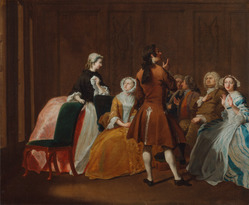This webtext centers on the work done in a doctoral seminar at the University of Louisville in 2013 entitled “Clarissa and Blogs.”1 During the course of the semester, participants read Samuel Richardson’s 1748 epistolary novel; selected and edited some of the letters in the novel; posted these selections as entries in two blogs; and wrote responses to those original blog posts. At the same time, participants read deeply in theoretical work about narrative, writing and the self, as well as scholarly work about blogs,2 and selected scholarship on Clarissa. Moreover, participants began to follow contemporary blogs, particularly those that resembled the remediated Clarissa blog: a single author, mostly using written text, narrating and reflecting on some aspect of identity construction (Fitzpatrick, 2007). The primary activity of the seminar was bringing together a variety of texts that illuminate how people shape narrative identities as they write for an audience, particularly in times of stress, complexity, and trauma.
Our goals in this webtext are to 1) document our reflexive examination of the connections among narrative, writing, and the self that we performed as we read, responded to, analyzed, and wrote about Clarissa and blogs; and 2) offer a series of interpretive claims about how narrative functions as a powerful tool for the construction of a self, especially when that self is built within rhetorical interchange. The first goal is represented primarily in the sections entitled “Clarissa’s Blog” and “Lovelace’s Blog.” Here, as we remediate parts of Clarissa as a blog and respond to those blog entries, we document our growing understanding of Clarissa and the role of narrative and writing in the construction of a self. The second goal is represented primarily in the sections entitled “Blogs we Follow” and “Narrative, Writing, and the Self.” Here we analyze contemporary blogs and various parts of Clarissa in order to offer a variety of interpretive claims about how a particular self is built through written narration. The distinction between documenting learning and offering interpretive argument is somewhat arbitrary, of course, because learning is documented in all aspects of the blog, and the acts of reading and responding are themselves those of analysis and interpretation.
We hope this webtext demonstrates the value for Composition and Rhetoric, as a discipline and practice, to continue embracing an expansive view of textuality—one that ranges from very complex and formal literary genres to the kinds of emerging genres that populate our daily lives. Even a canonical and historically distant novel, such as Clarissa, can be a rich site for analysis pertinent to the interests of students in our field. We also suggest that understanding the ways texts work, as texts, offers us a more potent knowledge of the structural dimensions of how stories are told and experienced. We further hope ClarissaBlogs exemplifies the possibilities for organizing a class around the collaborative construction of a large and complex project; we believe the form ClarissaBlogs takes is flexible and multifaceted enough to allow multiple students to carve out their own areas of interest, but unified enough to function—in some sense—as a coherent whole.
In the following sections of this Introduction we 1) describe the Central Texts We Explore, 2) provide more information on the intellectual context of the seminar, particularly the Theoretical Warrants on which we drew, and 3) discuss the Organization and Navigation of our text.
